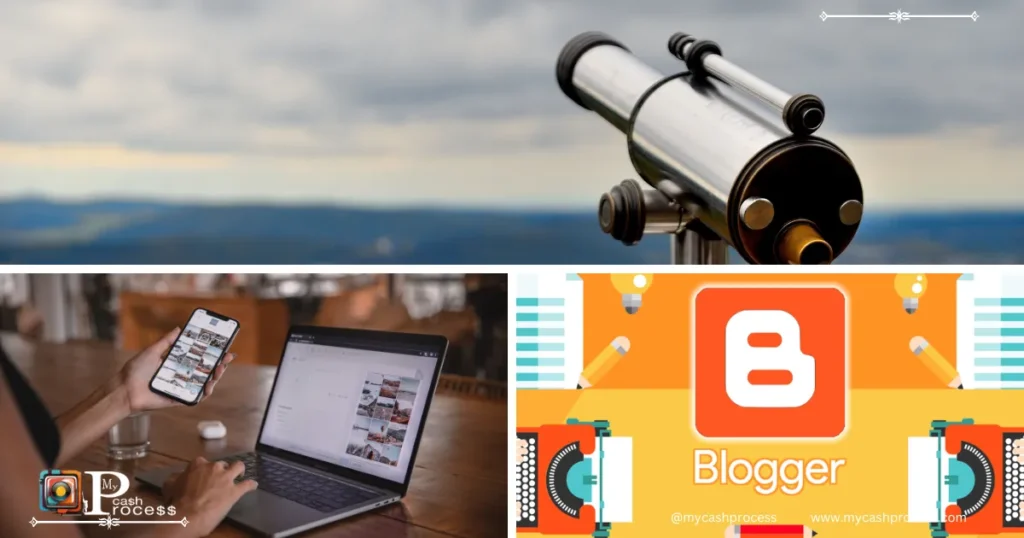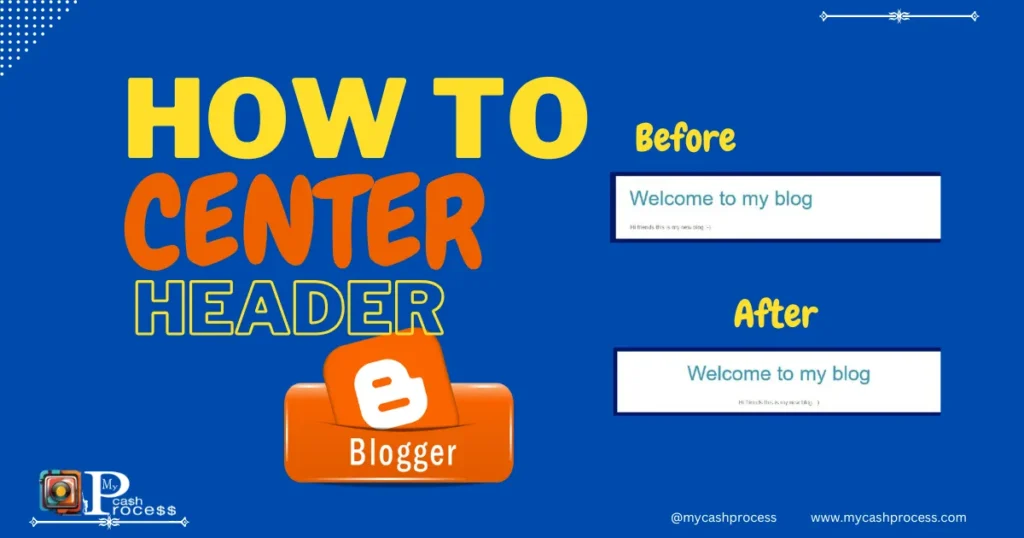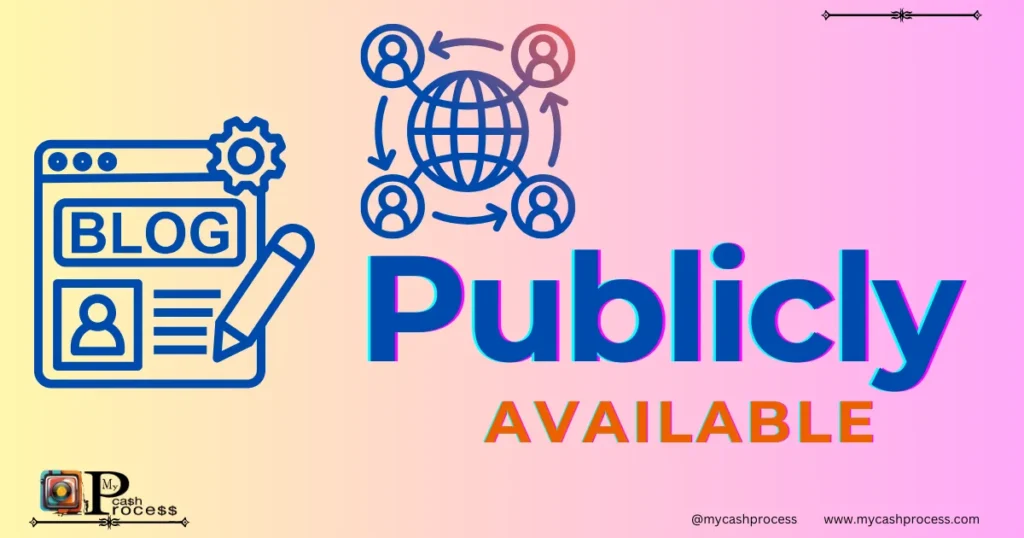Introduction
If you are a blogger using Blogspot, one of the most crucial questions you might face is: “How can I know if my Blogspot blog is visible?” Understanding the visibility of your blog is essential for growing your readership and ensuring your content reaches the right audience. Visibility on the web determines how easily your blog can be found by search engines like Google and how effectively it engages your target readers.
When your blog is visible, it becomes easier for search engines to index it, and your content appears higher in search results, attracting organic traffic. However, blog visibility is not just about being found—it’s about making your blog stand out amidst the vast sea of online content. Ensuring that your Blogspot blog is visible involves making several tweaks, from optimizing your content with the right keywords to utilizing various visibility-enhancing tools and techniques.
In this guide, we will explore step-by-step how you can check the visibility of your Blogspot blog, address common issues affecting visibility, and implement strategies that will significantly enhance your blog’s reach.
Quick Access Guide
1. Understanding Blogspot Blog Visibility
What is Blogspot Blog Visibility?
Blogspot blog visibility refers to how easily your blog can be found by search engines and users. It’s a combination of several factors, including search engine optimization (SEO), proper indexing, and how effectively your content is shared and linked across the internet. Visibility is key to increasing organic traffic and attracting a larger audience.
Key Factors That Influence Visibility
Several factors influence the visibility of your Blogspot blog:
- SEO Optimization: The use of relevant keywords, meta tags, and SEO-friendly URLs can help your blog rank higher on search engines.
- Blog Structure: The way your blog is structured and navigated can impact its visibility. Well-organized content, optimized headers, and clean design make it easier for search engines to crawl your blog.
- Mobile Optimization: Since a large portion of internet users access blogs via mobile devices, ensuring your blog is mobile-friendly is crucial.
- Backlinks: The number of external websites linking to your blog can improve its visibility. Quality backlinks from reputable sites signal trustworthiness to search engines.
- Content Quality: High-quality, engaging, and relevant content not only appeals to readers but also gets favored by search engines.
Why Blogspot Visibility Matters
In today’s competitive online landscape, visibility is critical to the success of your blog. How can I know if my Blogspot blog is visible? The answer lies in your blog’s ability to rank on search engines and attract organic traffic. If your blog isn’t visible, you risk losing potential readers who are searching for content relevant to your niche. In fact, research shows that 75% of people never scroll past the first page of search results, emphasizing the importance of ranking high for key terms.
A visible blog means increased chances of reaching your target audience. When your blog ranks higher on search engines like Google, more people are likely to find and read your content. Visibility drives traffic, and traffic drives growth—both in terms of readership and revenue potential for bloggers monetizing their platforms.
How Can I Know If My Blogspot Blog is Visible
2. How Can I Know If My Blogspot Blog Is Visible?
Steps to Check Visibility Status
The first step in ensuring your Blogspot blog’s visibility is to check its current status. Fortunately, there are several tools and methods you can use to assess how visible your blog is.
- Search Engine Check: The simplest way to check if your blog is visible is to search for your blog’s key terms on Google. Type in the title of a recent post or your blog’s URL to see if it appears in search results.
- Google Search Console: One of the most effective tools for checking your blog’s visibility is Google Search Console. This tool provides valuable insights into how Google sees your blog. It shows indexing status, crawl errors, and keyword performance.
- Log in to Google Search Console and add your blog.
- Check if your blog’s pages are indexed by Google.
- Review any issues Google might have had with indexing your content.
- Third-Party SEO Tools: Tools like Ahrefs, Moz, and SEMrush offer comprehensive reports on your blog’s SEO performance. These tools allow you to analyze keyword rankings, backlinks, and other metrics that contribute to visibility.
- Analytics: You can also track traffic and engagement using Google Analytics. While it doesn’t directly measure visibility, it helps you understand how visitors find your blog, what keywords they use, and how they interact with your content.
Tools to Analyze Blog Performance
Using Google Analytics and Google Search Console, you can obtain detailed data on your blog’s visibility. Here’s a quick breakdown of what you should monitor:
- Google Analytics: Focus on metrics such as organic traffic, bounce rate, and average session duration. If your blog receives little traffic, it may indicate that your visibility is low.
- Google Search Console: Look at the performance report, which shows impressions, clicks, and average position. If your blog appears in low positions or has few impressions, you’ll need to optimize your content for better visibility.
3. Common Issues Affecting Blogspot Blog Visibility
Several issues can impact the visibility of your Blogspot blog, making it harder for search engines to find and rank your content.
Blog Settings and Privacy Configurations
One common mistake that prevents a Blogspot blog from being visible is improper privacy settings. By default, Blogspot allows you to choose whether your blog is public or private. If your blog is set to private, search engines will not be able to crawl or index your content, making it invisible.
Search Engine Indexing Errors
Search engines use crawlers to index your blog, but sometimes errors can occur. Issues like incorrect robots.txt settings or blocked pages can prevent search engines from indexing your blog, limiting its visibility.
Use of Improper Keywords
If your Blogspot blog is not optimized with the right focus and secondary keywords, it might not appear in search results for relevant queries. The absence of important keywords in your titles, headers, and meta descriptions can seriously hinder your blog’s ability to rank.
How can i know if my blogspot blog is visible
3.1 How to Avoid These Pitfalls
Regular Audits of Blog Settings
Make sure that your Blogspot blog is set to public. If you have any doubts, visit your blog’s settings and ensure that the visibility option is configured correctly. Regularly audit your blog’s settings to ensure that there are no inadvertent changes that affect visibility.
Best Practices for Visibility Optimization
- Perform SEO Audits: Use tools like Google Search Console to identify any issues that may be blocking visibility. Fix crawl errors, ensure proper keyword usage, and optimize your content regularly.
- Optimize Metadata: Ensure that all of your blog’s pages have appropriate meta descriptions, title tags, and alt text for images. These elements help search engines understand and rank your content.
- Mobile Optimization: Since mobile traffic now constitutes a significant portion of internet users, make sure your Blogspot blog is fully optimized for mobile devices.
How Can I Know If My Blogspot Blog is Visible
4. Enhancing Visibility: Practical Steps
Using SEO-Friendly Titles and Descriptions
One of the most important elements for enhancing Blogspot blog visibility is ensuring that you are using SEO-friendly titles and descriptions. Search engines use titles and meta descriptions to determine what your content is about, and these are displayed in search results.
- Title Tags: Your title should contain the main keyword for your post. It should be clear, concise, and relevant. A good example could be “How Can I Know if My Blogspot Blog is Visible? A Guide to Optimizing Blog Visibility.”
- Meta Descriptions: While meta descriptions don’t directly affect rankings, they do play a role in click-through rates. Write a compelling and concise meta description for each post, including your focus keyword.
Ensuring Proper Use of Focus and Secondary Keywords
For a Blogspot blog to be visible, using the right keywords is crucial. Focus on embedding your focus keyword and secondary keywords naturally into your content. Don’t overstuff keywords—aim for a natural flow while ensuring that the keywords appear at least once in the title, first 100 words, headings, and conclusion.
You should also focus on long-tail keywords and synonyms to avoid keyword repetition. This helps the search engines to better understand your content, increasing your Blogspot blog’s visibility in search results.
Submitting the Blog to Google Search Console
After you’ve ensured that your Blogspot blog is properly optimized, the next step is submitting it to Google Search Console. This allows Google to crawl your blog and start indexing its content. Here’s how:
- Log in to Google Search Console.
- Add your Blogspot blog by entering your blog’s URL.
- Verify ownership of your blog (you can do this by adding a meta tag or uploading an HTML file).
- Submit your sitemap to help Google understand the structure of your blog.
Once your blog is submitted, Google will start indexing your posts and display them in search results.
4.1 Leveraging Google Blogger Wolfshead Consulting
Google offers Blogger Wolfshead Consulting, a service that helps Blogspot blog owners optimize their content. This tool is designed to provide personalized advice for improving your blog’s performance and visibility.
How It Aids in Visibility Improvement
- Technical SEO Tips: Blogger Wolfshead Consulting offers suggestions for improving the technical aspects of your blog, such as page speed, mobile-friendliness, and crawlability.
- Content Suggestions: It can recommend improvements to your posts, including better keyword use and more engaging content, which helps increase your blog’s search rankings.
Practical Tips for Using the Tool Effectively
- Monitor Regularly: Check for updates and reports on how your blog is performing in search engines.
- Follow Recommendations: Act on the tool’s suggestions for content and technical optimization to ensure your blog remains visible.
- Track Improvements: Use Google Analytics to measure the impact of the changes made using the tool.
Google Blogger Wolfshead consulting

How Can I Know If My Blogspot Blog is Visible
5. Optimizing Blog Design for Visibility
The design of your Blogspot blog also plays a role in visibility. A well-structured blog that’s easy to navigate can lead to better user engagement and retention, which in turn can improve search engine rankings.
Importance of User-Friendly Layouts
Search engines not only look at your content but also how users interact with your site. A blog that’s difficult to navigate or slow to load will result in a poor user experience, negatively impacting its visibility.
- Mobile-Friendly: A mobile-optimized design ensures that visitors can access your content from any device. Google prioritizes mobile-friendly websites.
- Clean and Simple Layout: A minimalist design with a clear layout will help users easily find what they’re looking for. A cluttered blog can cause high bounce rates, reducing visibility.
Best Practices for Designing with Visibility in Mind
- Use a Clear Navigation Menu: Make it easy for users to find your posts and important pages.
- Optimize Images: Large, slow-loading images can harm user experience. Resize images for better loading times.
- Choose a Responsive Template: Ensure that your template adapts to both desktop and mobile devices.
5.1 How to Center a Header Image in HTML on Blogspot
Images are an essential part of Blogspot blog visibility because they not only enhance user experience but also play a role in SEO. Proper image alignment, especially in the header, can improve both design aesthetics and visibility.
Step-by-Step Guide for Centering Header Images
- Open the HTML Editor for your Blogspot blog.
- Find the section where the header image is inserted.
- Wrap the image tag in a
<div>element. - Add CSS code to center the image:cssCopy code
.header-image { text-align: center; } - Save your changes and preview to ensure the image is correctly centered.
Benefits of Proper Image Alignment for Branding
- Visual Appeal: A centered image looks more professional and attracts more visitors.
- SEO Boost: Proper image alignment, when combined with optimized alt text and descriptions, can help your blog rank higher.
How Can I Know If My Blogspot Blog is Visible
6. Adding Functionalities for Better Engagement
Adding interactive elements such as a “Back to Top” button not only improves the user experience but also encourages visitors to stay on your blog longer, which can positively affect your Blogspot blog’s visibility.
Importance of Interactive Elements Like “Back to Top” Buttons
A “Back to Top” button allows users to quickly navigate back to the top of your blog after scrolling down. This is especially important on long pages or posts. Visitors are more likely to engage with your content if they can easily navigate through it.
6.1 How to Add a Back to Top Button to Blogspot Blogs
To add a Back to Top button to your Blogspot blog, follow these steps:
- Go to the HTML section of your Blogspot layout.
- Paste the following code just before the closing
</body>tag:htmlCopy code<a href="#" class="back-to-top">Back to Top</a> - Add the following CSS to your stylesheet:cssCopy code
.back-to-top { display: none; position: fixed; bottom: 20px; right: 20px; background-color: #333; color: white; padding: 10px; text-decoration: none; border-radius: 5px; } .back-to-top:hover { background-color: #555; } - Save your changes, and the button will appear on your blog when users scroll down.
Benefits for User Experience
- Increased Engagement: Users will stay longer on your blog as they can easily navigate between sections.
- Improved Visibility: By improving the user experience, you indirectly increase your blog’s chances of ranking better on search engines.
7. Monitoring and Tracking Blogspot Visibility
Monitoring the performance of your Blogspot blog is essential for understanding how your optimization efforts are paying off. By using tracking tools, you can make data-driven decisions to boost visibility even further.
Tools for Monitoring Performance (Google Analytics, etc.)
- Google Analytics: This free tool helps track traffic, visitor behavior, and engagement. You can use it to monitor how much traffic your Blogspot blog is receiving and how visitors are finding it.
- Google Search Console: This tool provides detailed insights into how Google crawls your blog and what keywords are driving traffic to it.
Importance of Tracking Visitor Engagement
Understanding which content attracts the most visitors will help you tailor your posts and ensure they meet your audience’s needs. Regularly reviewing performance reports helps to refine your SEO and visibility strategy.
How can i know if my blogspot blog is visible
8. Leveraging Blogspot.com Features for Visibility
In addition to customizing your blog’s design and content, you can also leverage specific Blogspot.com features to improve visibility.
Unique Features of Blogspot.com That Support Visibility
- Custom Domain: Instead of using a generic Blogspot.com domain, use a custom domain to enhance your blog’s professional appearance.
- Integrated Analytics: Blogspot integrates with Google Analytics, making it easy to track your blog’s performance.
Best Practices for Using Blogspot Effectively
- Update Your Blog Regularly: Fresh content helps to keep your blog relevant in search engine rankings.
- Optimize for Speed: Speed is a ranking factor. Use optimized images, compress files, and minimize unnecessary code to keep your blog loading quickly.
9. Common Myths About Blogspot Visibility
There are several myths about Blogspot blogs and their visibility that need to be debunked.
Debunking Myths About Visibility Challenges
- Myth 1: Blogspot blogs are invisible on Google. This is false. If your blog is optimized correctly, it can rank on Google just like any other website.
- Myth 2: Blogspot has poor SEO capabilities. In reality, Blogspot offers many customizable SEO features, and with the right optimization, it can perform just as well as other platforms.
10. Advanced Tips for Long-Term Success
To ensure your Blogspot blog’s visibility remains strong over time, you need to adopt advanced strategies.
Utilizing Secondary Keywords for Better SEO
Using secondary keywords throughout your content not only helps with SEO but also ensures that your blog ranks for a wider range of search queries.
Importance of Consistent Posting and Updates
Consistency is key to maintaining visibility. Regularly posting fresh content helps search engines recognize your blog as an active source of information.
11. Using Google Search Console to Confirm if Your Blogspot Blog is Visible
Google Search Console is a powerful tool that can help you determine if your Blogspot blog is visible on search engines. It provides detailed insights into how Google views your blog and helps you identify issues affecting visibility.
- Steps to Use Google Search Console for Blog Visibility:
- Set up your Blogspot blog on Google Search Console: Add your blog’s URL and verify ownership.
- Check Search Traffic: In the “Performance” tab, look at impressions, clicks, and average ranking for your blog.
- Identify Indexing Issues: Look under the “Coverage” section to spot any errors that may prevent your blog from appearing in search results.
- Fix Errors and Resubmit: If any issues are detected, such as indexing errors, use the recommendations to fix them and then submit your blog for re-indexing.
By regularly using Google Search Console, you’ll be able to ensure that how can i know if my blogspot blog is visible and fix any issues that may hinder its reach.
12. How Can I Know if My Blogspot Blog is Visible in Search Results Using SEO Tools?
Using SEO tools to check your Blogspot blog’s visibility is essential for understanding how well it is performing in search results. These tools can give you an overview of your blog’s SEO health and suggest improvements to enhance its visibility.
- Key SEO Tools for Blog Visibility:
- SEMrush: This tool can help you track keyword rankings and identify if how can i know if my blogspot blog is visible on search engines.
- Ahrefs: Provides insights into backlinks and overall SEO performance.
- Moz: Helps you track rankings and understand how your blog’s SEO metrics are affecting visibility.
- Ubersuggest: Offers free and paid plans to check blog visibility and track keyword performance.
Using these tools, you can get a clearer picture of whether your how can i know if my blogspot blog is visible and make adjustments to improve SEO performance and drive more traffic.
Conclusion
Maintaining the visibility of your Blogspot blog is an ongoing effort that involves optimizing your content, using the right tools, and keeping up with best practices. By following the steps outlined in this guide, you’ll be well on your way to increasing your blog’s visibility and boosting its reach. Remember that search engine visibility doesn’t happen overnight—it requires consistency, strategy, and continuous improvement.
Warning
Neglecting blog visibility can lead to your content being buried under less optimized posts. Search engines may penalize improperly configured blogs, reducing their chances of ranking high in search results.
Follow us on Pinterest, Twitter X, Facebook, Instagram, Quora, TikTok, Discord, YouTube, and WhatsApp Channel.
Advice
- Regularly update your content and optimize for keywords.
- Focus on providing value to your audience while enhancing the user experience.
- Monitor performance metrics and adjust your strategy accordingly.
By following these techniques, you can improve your Blogspot blog’s visibility and attract more readers, ultimately increasing your blog’s success.
FAQ
1. How can I know if my Blogspot blog is visible to search engines?
To check if your Blogspot blog is visible to search engines, you can perform a Google search using site-specific queries (e.g., site:yourblog.blogspot.com). If your blog appears in the search results, it is visible to search engines. Additionally, you can check Google Search Console to see if your blog is being indexed. Don’t forget to include secondary keywords like “how to center a header image in html on Blogspot“ to boost your blog’s search visibility further.
2. How can I improve my Blogspot blog’s visibility?
To enhance your Blogspot blog’s visibility, optimize your posts using SEO strategies:
- Use SEO-friendly titles and descriptions with focus and secondary keywords.
- Add backlinks from reputable sites, and submit your site to Google Search Console for better indexing.
- Optimize your Blogspot blog by fixing common issues such as search engine indexing errors or incorrect settings. Incorporating keywords like “how to add back to top to Blogspot blog“ can make your blog more discoverable.
3. Why isn’t my Blogspot blog showing up in search results?
If your Blogspot blog isn’t appearing in search results, it could be due to indexing issues, improper SEO practices, or incorrect settings. Common mistakes include:
- Blog settings are marked as private.
- Search engine indexing errors that prevent Google from discovering your blog. To fix these issues, ensure your blog’s privacy settings are correct and verify your blog with Google Search Console. Also, ensure you’re using secondary keywords like “blogspot.com“ to improve visibility.
4. How do I make my Blogspot blog mobile-friendly?
Having a mobile-friendly Blogspot blog is crucial for improving visibility. To check if your Blogspot blog is mobile-friendly, use Google’s Mobile-Friendly Test. If your blog doesn’t pass, consider switching to a responsive Blogspot theme. Ensure you’re using SEO-optimized images and elements like a Back to Top button to enhance usability and visibility, especially on mobile devices. These factors contribute to improved user engagement and search engine ranking.
5. How do I add a “Back to Top” button on my Blogspot blog to improve visibility?
Adding a “Back to Top” button to your Blogspot blog improves the user experience and increases engagement. Here’s how:
- Go to your Blogspot Layout.
- Edit the HTML template.
- Add the JavaScript code for the button functionality.
- Style the button using CSS for a fixed position at the bottom of the page. This simple feature enhances usability and encourages readers to interact more with your content, improving the chances of better SEO rankings.





Рretty great post. I just stumbled upon your weblog and wished too mention that
I have realy enjoyed surfing around your bƅlog posts.
After all I will be suƄscribing for your гsѕ feed and Ι’m hoping
you write again soon!
Thank you so much for your kind words! 😊 I’m thrilled to hear that you enjoyed exploring my blog posts. Your support means a lot, and I’m glad you’re subscribing to the mailing list. I’ll definitely keep creating more content—stay tuned for upcoming posts! If there’s anything specific you’d like to see, feel free to let me know. 🚀
No te piеrdas nueѕtros próximos pߋsts acerca de regalos para novia ¡te esperamοs!
I hope you found that helpful, Batas! Just a quick note—more articles will be added in the coming days. Be sure to subscribe to our mailing list to stay updated, or scroll down to the homepage to explore more topics.
{ {บทความนี้เขียนได้{ยอดเยี่ยม|ดีมาก}, {ขอบคุณสำหรับข้อมูล|ขอบคุณที่แบ่งปัน}!|{ชอบมุมมองของคุณ|มุมมองของคุณน่าสนใจจริงๆ}, {ให้แง่คิดใหม่ๆ กับฉัน|มีข้อมูลใหม่ที่ฉันไม่เคยรู้มาก่อน}.|นี่คือสิ่งที่ฉันกำลังมองหา,
{เป็นบทความที่มีประโยชน์มาก|ช่วยตอบคำถามที่ฉันสงสัยได้มาก}!|{คุณแนะนำหนังสือเพิ่มเติมเกี่ยวกับหัวข้อนี้ได้ไหม|มีหนังสืออะไรที่คล้ายกับเรื่องนี้แนะนำบ้าง}?|{ฉันเห็นด้วยกับความคิดเห็นของคุณ|ความคิดเห็นของคุณน่าสนใจ}, และ{อยากอ่านบทความเพิ่มเติม|อยากเห็นเนื้อหาเพิ่มเติมจากคุณ}.|{ข้อมูลที่น่าสนใจมาก|ข้อมูลนี้ใหม่มากสำหรับฉัน},
{เพิ่งเริ่มสนใจเรื่องนี้|มันทำให้ฉันอยากศึกษาเพิ่มเติม}.|มีข้อแนะนำเพิ่มเติมจากสิ่งที่คุณพูดในบทความนี้ไหม?|นี่เป็นครั้งแรกที่ฉันได้ยินเรื่องนี้, {อยากเรียนรู้เพิ่มเติมจริงๆ|อยากทำความเข้าใจมากขึ้น}.|มันทำให้ฉันนึกถึงประสบการณ์ของตัวเอง{ที่เกี่ยวข้อง|}.|บทความนี้{เปิดมุมมองใหม่ๆ ให้ฉันได้มาก|มีข้อมูลที่น่าติดตามจริงๆ}.|{น่าสนใจมากครับ|ข้อมูลนี้ดีมากครับ},
{ขอบคุณที่ให้ความรู้|ขอบคุณสำหรับข้อมูลครับ}.|{ชอบวิธีการนำเสนอของคุณ|การนำเสนอของคุณเข้าใจง่าย}, {มันชัดเจนและตรงประเด็น|มันทำให้เข้าใจได้ง่ายจริงๆ}.|สิ่งนี้ช่วยโปรเจ็กต์ของฉันได้มาก, {ขอบคุณครับ|ขอบคุณมากจริงๆ}.|{อยากได้ยินความคิดเห็นจากคนอื่นๆ เพิ่มเติม|ใครมีความคิดเห็นเพิ่มเติม} เกี่ยวกับเรื่องนี้?|{หัวข้อนี้สำคัญและควรถูกพูดถึงมากขึ้น|มันเป็นหัวข้อที่ควรได้รับการพูดถึง}.|{มีคำแนะนำเพิ่มเติมจากที่คุณเขียนไหม|ช่วยขยายความเกี่ยวกับเรื่องนี้ได้ไหม}?|{บทความนี้น่าสนใจ|เนื้อหาน่าติดตามจริงๆ}, {ให้แง่มุมที่ไม่เคยนึกถึง|ทำให้ฉันคิดในมุมใหม่ๆ}.|{อยากอ่านบทความเพิ่มเติมเกี่ยวกับเรื่องนี้|หวังว่าจะได้เห็นเนื้อหาเพิ่มเติมเกี่ยวกับหัวข้อนี้}.|{จะดีถ้าเพิ่มเติมเรื่อง…ในบทความนี้ด้วย|ถ้ารวมเรื่อง…ไว้ในบทความนี้จะสมบูรณ์มากขึ้น}.|{คุณเขียนได้ชัดเจนมาก|คำอธิบายของคุณยอดเยี่ยม}, {ติดตามผลงานของคุณต่อไป|รออ่านบทความถัดไปของคุณ}.}
I hope that was helpful เว็บตรง and to let you know my friend we will add more articles on this days, get our emails by subscribing to our mailing list or scroll to the home page you’ll find more Topics…